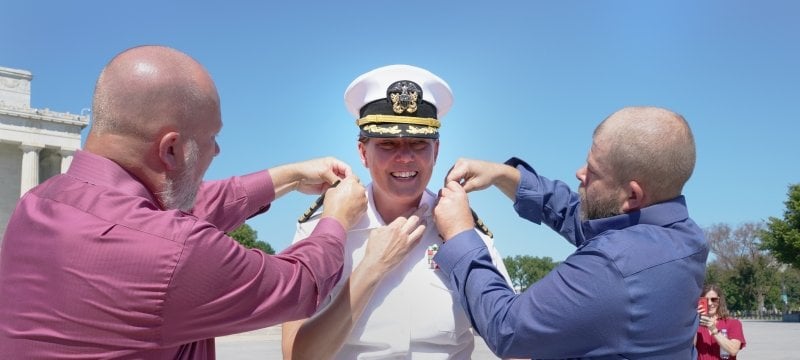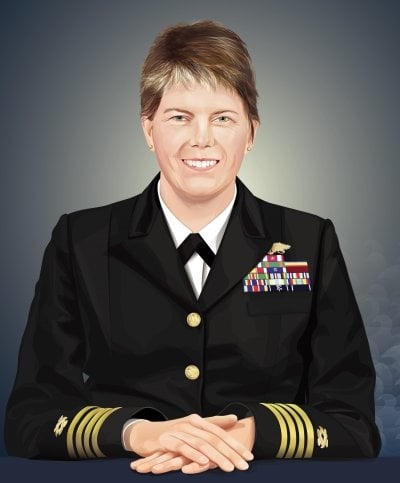Civil engineering alumna Juliana M. Strieter '96 was promoted to the rank of captain in the United States Navy in September 2022. In this Q&A, Strieter talks about her time at Tech and the highlights and challenges of her naval career, and offers advice to those looking to test uncharted waters.
Before joining the Navy, Captain Strieter—a native of Lake Linden, Michigan—came to Michigan Tech to play basketball. She enlisted before finishing her bachelor's degree. As an officer, her tours include deployment to the Middle East with Naval Mobile Construction Battalion 4, serving as Charlie Company commander and assistant training officer in support of Operation Iraqi Freedom.
In 2014, she became the first permanent party stationed at Naval Support Facility Deveselu, Romania, and helped lead the Navy's first new installation in more than 20 years. Strieter later served as the facilities sustainment, restoration, and modernization analyst to the staff of the chief of naval operations and oversaw all aspects—from programming to execution of sustainment and recapitalization— across the Navy's $305 billion shore enterprise.
Q. You grew up in Lake Linden, not far from campus. Did you always want to go to Michigan Tech?
JS. No. I was interested in pursuing an architectural degree. I was recruited by several colleges to play basketball, but none had this degree program. Since Tech had engineering, I decided to study civil engineering.

Q. You enlisted in the Navy before you finished your bachelor's degree. Can you tell us more about that decision?
JS. I was 3 credits short and felt stuck in a rut. I had taken EE301 (Elements of Electric Circuits) several times and couldn't pass the class. I needed to do something, so joining the Navy was something to do. The recruiter offered me the engineer aide rating since I was a civil engineering student, but I wasn't interested. After I took the practice entrance exam, he offered me rates in the nuclear field. As I needed 3 credits in EE, I selected nuclear electronics technician. Plus, it had the longest and hardest initial training pipeline. I wanted to challenge and prove to myself that I could complete it.
Q. What are some of the highlights of your career thus far in the Navy's Civil Engineer Corps?
JS. I'm not sure if these can be considered highlights, but they're definitely some great opportunities I've been able to experience.
I went 35 days without a shower on my deployment to Iraq in 2003 with Naval Mobile Construction Battalion 4 as a lieutenant junior grade. Thanks to my family for sending me a bunch of baby wipes to keep clean!
I was the officer in charge of the Naval Support Unit State Department for three years as a lieutenant and lieutenant commander. I traveled between three to six weeks each quarter, depending on the part of the world. I got to visit a lot of places that I would not have had a chance to otherwise—Great Wall of China, St. Basil's in Moscow, Machu Picchu in Peru. I went on a four-day safari in Kenya, spent Christmas in Sydney, Australia, and Easter in Austria.
I was the first permanent party to be stationed at a Naval Support Facility (NSF) in Deveselu, Romania, in July 2014. Absolutely loved Romania and the people.
I had the honor to be a plank owner (in this case, a member of shore command when that command was commissioned) of two commands: Naval Facilities Engineering Systems Command Mid-Atlantic and NSF Deveselu.
Q. You were promoted to captain in September—congratulations! In the press release announcing your promotion, the Navy said you had broken barriers. What are some of the barriers you encountered?
JS. Thank you. Honestly, I don't know, as I didn't consider them barriers, but challenges. When I joined in 1995, there were not many women within the nuclear field. I think we only had about a dozen (or so) women in the reactor department on the USS Eisenhower. The Civil Engineer Corps, similar to the engineering community, is predominately male. Women make up about 10 percent. Many times throughout my career, I was the only woman on the team, in the meeting, etc.
I discovered during college that many men are intimidated by me due to my height (over six feet), so I believe my presence alone helps me stand out. Being a female service member has its unique physical challenges on a ship, in field exercises, or on deployment to a place like Iraq. I wanted my career to be challenging and fulfilling.
During a performance review when I was a junior lieutenant, my boss recommended me for a flag aide position. You had to be nominated to be considered. I told him I didn't think I would compete well. He stated I would, and said he thought I had an excellent chance of getting the position—which I did. That was the moment I realized I was holding myself back, that I could do anything I wanted. My personal motto became "Why not?" The worst someone could tell me was no. So, I went out of my comfort zone and challenged myself to go after the jobs and locations that were difficult.
Q. What's your advice to those who find themselves charting new paths in their professions?
JS. Get out of your comfort zone. Challenge yourself. Go after the "hard" jobs. Take pride and ownership of your work. Don't be afraid to tell the truth or your opinion. If someone asks you, don't say what you think they want to hear! They are asking because your opinion is valued.
Q. One last question: What's your favorite Michigan Tech memory?
JS. I'm not sure I have just one! The experience of playing on the women's basketball team. Flying for the first time when we went down to Florida to play in a tournament during the holiday break. Civil engineering professors (Bogue) Sandberg and (Bill) Bulleit. The fall conditioning time—playing soccer or trying to play water polo. I have so many good memories of my years at Tech.
Michigan Technological University is an R1 public research university founded in 1885 in Houghton, and is home to nearly 7,500 students from more than 60 countries around the world. Consistently ranked among the best universities in the country for return on investment, Michigan's flagship technological university offers more than 185 undergraduate and graduate degree programs in science and technology, engineering, computing, forestry, business, health professions, humanities, mathematics, social sciences, and the arts. The rural campus is situated just miles from Lake Superior in Michigan's Upper Peninsula, offering year-round opportunities for outdoor adventure.





